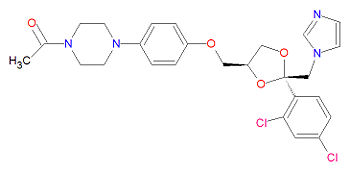Ketoconazole: Difference between revisions
imported>David E. Volk m (→Brand names) |
imported>David E. Volk No edit summary |
||
| Line 11: | Line 11: | ||
== Chemistry == | == Chemistry == | ||
The IUPAC chemical name for ketoconazole is 1-[4-[4-[[2-(2,4-dichlorophenyl)-2-(imidazol-1-ylmethyl)-1,3-dioxolan-4-yl]methoxy]phenyl]piperazin-1-yl]ethanone. It has chemical formula C<sub>26</sub>H<sub>28</sub>C<sub>l2</sub>N<sub>4</sub>O<sub>4</sub> and registered under CAS Number 79156-75-5. | The IUPAC chemical name for ketoconazole is 1-[4-[4-[[2-(2,4-dichlorophenyl)-2-(imidazol-1-ylmethyl)-1,3-dioxolan-4-yl]methoxy]phenyl]piperazin-1-yl]ethanone. It has chemical formula C<sub>26</sub>H<sub>28</sub>C<sub>l2</sub>N<sub>4</sub>O<sub>4</sub>, a molecular mass of 531.4309 g/mol and is registered under CAS Number 79156-75-5. | ||
== Drug interactions == | |||
=== Drug with enhanced effectiveness when taken with ketoconazole === | |||
Ketoconazole increases the effectiveness, and therefore toxicity of many medications. It increases the effectiveness of some anticoagualant medications, including [[acenocoumarol]], [[anisindione]], [[dicumarol]] and [[warfarin]] and the effectiveness and toxicity of some [[steroid]]s, including the [[corticosteroid]]s [[methylprednisolone]], [[prednisolone]] and [[prednisone]]. It also increase the effects of some [[antiviral drug]]s, including [[indinavir]], [[ritonavif]] and [[saquinavir]]. Many [[benzodiazepine]]-based drugs, including [[alazepam]], [[alprazolam]], [[chlordiazepoxide]], [[clonazepam]], [[clorazepate]], [[diazepam]], [[estazolam]], [[flurazepam]], [[midazolam]], [[quazepam]] and [[triazolam]] are more effective when taken with ketoconazole. | |||
Note: This section is still in progress | |||
== Synonyms == | == Synonyms == | ||
Revision as of 16:22, 3 March 2008
Ketoconazole is one of the azole-based antifungal drugs used to treat fungal infections. Its use has greatly diminished because of the introduction of better treatment alternatives, including the triazoles fluconazole and itraconazole. It is based on imidazole as are clotrimazole, fluconazole, itraconazole and miconazole. It is a second-line of defense systemic drug use to treat candidiasis, candiduria, oral thrush, mucocutaneious candidiasis, blastomycosis, coccidioidomycosis, histoplasmosis, chromomycosis and paracocccidioidomycosis.
Mechanism of action
Azole-based antifungal agents, such as ketoconazole, work by inhibiting the enzyme cytochrome P450 14--demethylase (P45014DM), which is part of the sterol biosynthesis pathway that converts lanosterol to ergosterol[1]. Because ketoconazole has less affinity towards fungal cell membranes than the newer triazole antifungal agents like fluconazole and itraconazole, it is more likely to bind with mammalian cell membranes and induce toxicity[2]. .
Side effects
Becuase ketoconazole disrupts part of the sterol biosynthesis pathway, it may decrease levels of the steroids testosterone and cortisone causing gynecomastia and oligospermia in males and irregular menstration in women. It may also cause anorexia, nausea and vomiting, increased levels of transaminase and liver toxicity.
Chemistry
The IUPAC chemical name for ketoconazole is 1-[4-[4-[[2-(2,4-dichlorophenyl)-2-(imidazol-1-ylmethyl)-1,3-dioxolan-4-yl]methoxy]phenyl]piperazin-1-yl]ethanone. It has chemical formula C26H28Cl2N4O4, a molecular mass of 531.4309 g/mol and is registered under CAS Number 79156-75-5.
Drug interactions
Drug with enhanced effectiveness when taken with ketoconazole
Ketoconazole increases the effectiveness, and therefore toxicity of many medications. It increases the effectiveness of some anticoagualant medications, including acenocoumarol, anisindione, dicumarol and warfarin and the effectiveness and toxicity of some steroids, including the corticosteroids methylprednisolone, prednisolone and prednisone. It also increase the effects of some antiviral drugs, including indinavir, ritonavif and saquinavir. Many benzodiazepine-based drugs, including alazepam, alprazolam, chlordiazepoxide, clonazepam, clorazepate, diazepam, estazolam, flurazepam, midazolam, quazepam and triazolam are more effective when taken with ketoconazole.
Note: This section is still in progress
Synonyms
- (+-)-cis-1-acetyl-4-(p-((2-(2,4-dichlorophenyl)-2-(imidazol-1-ylmethyl)-1,3-dioxolan-4-yl)methoxy)phenyl)piperazine,
- 79156-75-5
- CPD-4503
- fungarest
- fungoral,
- ketoconazol,
- ketoconazole
- ketoderm
- ketoisdin,
- KW 1414
- NCI60_002728
- nizoral
- NSC317629
- orifungal M
- panfungol
Brand names
- Extina®
- Fungarest®
- Fungoral®
- Ketocanazole®
- Ketoconazol®
- Ketoconazol®
- Ketoconazole®
- Ketoconazolum®
- Ketoderm®
- Ketoisdin®
- Ketozole®
- Nizoral®
- Nizoral Cream®
- Nizoral Shampoo®
- Nizoral® A-D
- Nizoral® A-D Shampoo
- Orifungal®
- Orifungal M®
- Panfungol®
External links
- Doctorfungus [1]

